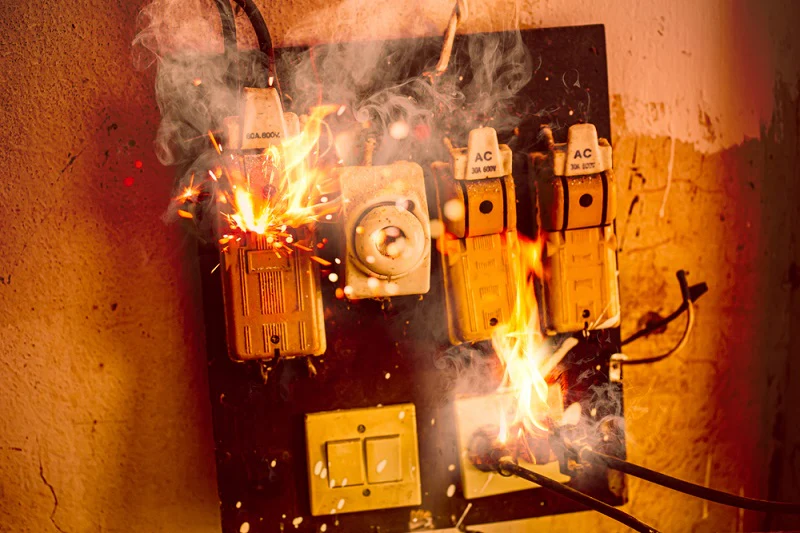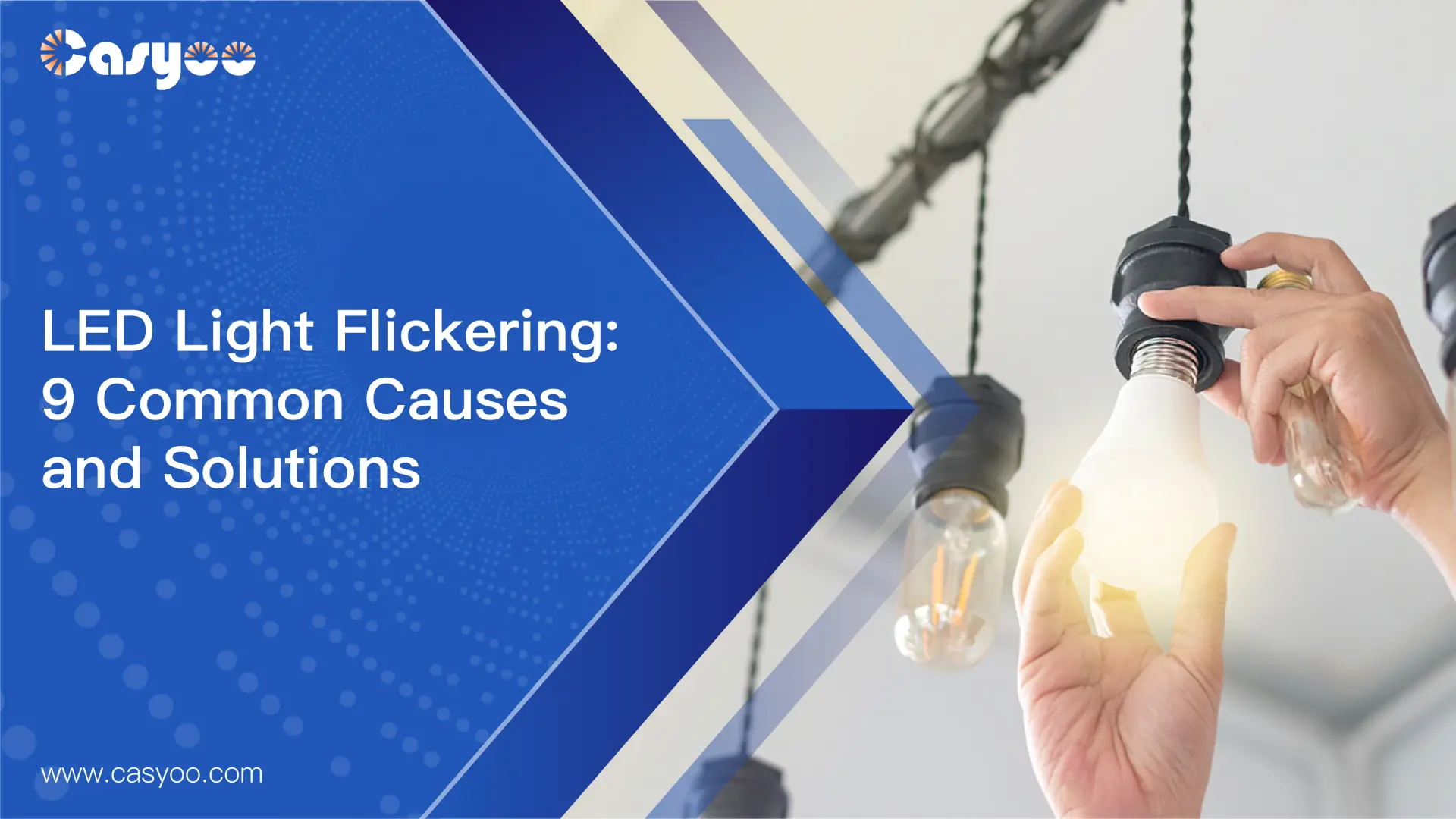LED lighting boasts a bunch of benefits including longer lifespan, long-term energy saving and so on, but LED light flickering is still a common potential concern. LED light flickering can be related to factors such as lamp quality, line connection, external environment, etc. In the following passage, we will analyse the most common 10 reasons and provide corresponding solutions.
What is LED light flickering?
It means that the output of the lamp changes rapidly and suddenly in a short period of time. If the flicker produces 50 flickers per second, it is obvious. LED lamps show significant flickering, and flickering occurs between 10% and 100% of the time. If an LED light flickers, it doesn’t necessarily mean it’s dying. While aging can cause flickering, it usually just indicates the light isn’t functioning correctly.
Why is your LED light flickering? 10 causes & how to fix LED flickering
LED light flickering results from various factors that include weak electrical connections, voltage irregularities, incompatible dimmer switches, aging light bulbs and so on. This section will analyze the leading 10 causes of LED light flickering and show you how to stop flickering LED lights.
1. Loose wiring
Cause: When the wires are not fastened tightly, it will disrupt the current flow, hence causing the connection to sometimes fail and reconnect.
Solution: Tighten the every electrical connections. If needed, when your LED light started flickering, get expert suggestion from an electrician to ensure the wiring is tightly connected.
2. Voltage fluctuation may cause LED light flickering
Cause: LED light flickering can be attributed to a key but often overlooked reason: voltage changes. These changes occur when the power supply voltage level is not normal. The voltage must be stable and consistent for fixtures to function properly. LED lights may flash due to voltage changes. This problem can be caused by external factors, including a power grid problem or electrical interruption in a house’s wiring. If you find your LED lights flicker when you plug other devices in the socket or LED light flickering when turned on, this is also caused by voltage fluctuation. Voltage fluctuations can damage to LED fixtures, although they are usually unseen to the naked eye.
Solution: Stabilize the power supply to successfully solve the LED flashing problem. In order for LED lights to work properly, the voltage must be constant. Flickering can be caused by external voltage fluctuations or grid problems. This problem can be reduced by installing a surge protector or voltage regulator. These gadgets maintain a constant voltage flow to the LED by regulating and stabilizing the voltage. By stabilizing the power supply voltage, you can eliminate flickers, make lighting comfortable and reliable, and extend the life of LED lights. This also protects your bulbs from the damaging effects of voltage fluctuations.

3. LED light flickering when using incompatible dimmer switch
Cause: Dimmers that are incompatible with LED lights are another typical source of flashing lights. Not all dimmer switches are designed to work with LEDs. If the wrong dimmer is used, the LED lights may flicker, buzz, or behave abnormally.
Solution: Choose a dimmer switch suitable for LED lights. Before installation, make sure to check the packaging or consult an electrician. Light bulbs and switches must be compatible.
4. Circuit overload
Cause: Undoubtedly, LED lighting uses less energy than traditional bulbs. However, if too many lights or other electronic devices are connected, the circuit can be overloaded. Thus, the circuit will be unable to provide stable power to all connected appliances or devices. Flickering LEDs will occur.
Solution: Avoid using many devices on one circuit at the same time.
5. Poor-quality LED lights
Cause: The performance of cheap lights is unstable because they often have defects or use components of poor quality.
Solution: Opt for reliable, high-quality LED lights. The chance of flickering is mitigated since these lights are strictly tested before shipping.
6. LED driver failure that leads to LED light flickering
Cause: The LED driver controls the received voltage of the LED fixture. When the LED light cannot steadily produce light due to faulty drivers, there will be a flicker.
Solution: Replace the faulty LED driver. Test or talk to an expert to determine which drivers are having problems. When you find faulty LED driver, replace them with compatible drivers.
7. Bulb aging
Cause: What causes a LED bulb to flicker? Maybe the flickering is caused by bulb aging. LED lights gradually deteriorate with time, which may lead to a flicker.
Solution: Buy new, reliable LED bulbs to replace the old ones. While LED lights do have a long service life, they don’t last forever.
8. Harsh weather conditions
Cause: LED lights flashing may be caused by extreme weathers, such as thunderstorms, especially when the lights are installed outdoors.
Solution: Install a surge protector or whole-house surge protection system. These gadgets can reduce flickers caused by external factors.
9. Electrical connection failure
Cause: LED lights flashing may be caused by poor electrical connections, which can interfere with current. This may be more systematic than some loose links.
Solution: Your home’s electrical system may need to be rewired. The LED flashing may just be a symptom.
10. Overheating
Cause: If an LED lamp overheats, it will cause the temperature to rise, which will affect other electronic components and cause flickering.
Solution: You can replace the original heat sink with a more efficient one, or use a new LED chip that dissipates heat more effectively. You can also consider use a lamp with lower power to reduce heat generation.
Are LED light flickering dangerous?
While flickering lights are not always a threat, some problems can occur if the problem is not addressed.
LED light flickering may cause fire
If a loose connection causes flickering, sparks may splash and cause a fire. In addition, a power supply problem can cause a power surge, which can start a fire.
Electric shock
If the flicker is caused by an unsafe link, an electric arc may occur. If you touch the lamp, you will feel electric shock. Also, if the current ignites anything else in the house, it could cause a fire.
Health problem
Blinking LED lights can be harmful to human health and cause many different health problems. There have been many studies on the influence of flickering LED lights on our health. For instance, you can read the report published by the IEEE Standards Working Group.
Can flickering LED lights cause headaches and migraines?
Flickering lights may cause or exacerbate migraines in people who are sensitive to them.
Impaired vision
Flickering LED lights can be a problem in workplaces and other environments that require long-time attention, as it can cause impaired vision.
Exhaustion and reduced efficiency
Blinking LED lights have been linked to mental exhaustion. Flashing lights can scatter the beam and cause glare, which hinders learning, makes working or studying more difficult, and reduces productivity.
Conclusion
If your LED light continues to flash, you need to find out the causes and take immediate steps to solve it. The sooner action is taken, the longer the service life of LED lights. Are you looking for reliable LED lights? Then contact us! We are 24/7 available to answer any questions you may have.




